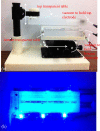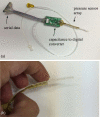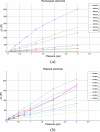Flexible Distributed Pressure Sensing Strip for a Urethral Catheter
- PMID: 27065719
- PMCID: PMC4824413
- DOI: 10.1109/JMEMS.2015.2444992
Flexible Distributed Pressure Sensing Strip for a Urethral Catheter
Abstract
A multi-sensor flexible strip is developed for a urethral catheter to measure distributed pressure in a human urethra. The developed sensor strip has important clinical applications in urodynamic testing for analyzing the causes of urinary incontinence in patients. There are two major challenges in the development of the sensor. First, a highly sensitive sensor strip that is flexible enough for urethral insertion into a human body is required and second, the sensor has to work reliably in a liquid in-vivo environment in the human body. Capacitive force sensors are designed and micro-fabricated using polyimide/PDMS substrates and copper electrodes. To remove the parasitic influence of urethral tissues which create fringe capacitance that can lead to significant errors, a reference fringe capacitance measurement sensor is incorporated on the strip. The sensing strip is embedded on a catheter and experimental in-vitro evaluation is presented using a bench-top pressure chamber. The sensors on the strip are able to provide the required sensitivity and range. Preliminary experimental results also show promise that by using measurements from the reference parasitic sensor on the strip, the influence of parasitics from human tissue on the pressure measurements can be removed.
Keywords: capacitive sensors; catheter pressure sensors; in vivo force sensors; in vivo sensors; instrumented catheter; parasitic capacitance; urethral sensors.
Figures























Similar articles
-
Instrumented Urethral Catheter and Its Ex Vivo Validation in a Sheep Urethra.Meas Sci Technol. 2017 Mar;28(3):035702. doi: 10.1088/1361-6501/aa5434. Epub 2017 Jan 13. Meas Sci Technol. 2017. PMID: 28959090 Free PMC article.
-
Distributed pressure sensors for a urethral catheter.Annu Int Conf IEEE Eng Med Biol Soc. 2015;2015:7610-3. doi: 10.1109/EMBC.2015.7320154. Annu Int Conf IEEE Eng Med Biol Soc. 2015. PMID: 26738054
-
An Instrumented Urethral Catheter with a Distributed Array of Iontronic Force Sensors.Ann Biomed Eng. 2021 Jan;49(1):149-161. doi: 10.1007/s10439-020-02528-7. Epub 2020 May 6. Ann Biomed Eng. 2021. PMID: 32377979
-
[Recommendations for the urodynamic examination in the investigation of non-neurological female urinary incontinence].Prog Urol. 2007 Nov;17(6 Suppl 2):1264-84. Prog Urol. 2007. PMID: 18214138 Review. French.
-
Single-Line Multi-Channel Flexible Stress Sensor Arrays.Micromachines (Basel). 2023 Aug 3;14(8):1554. doi: 10.3390/mi14081554. Micromachines (Basel). 2023. PMID: 37630090 Free PMC article. Review.
Cited by
-
Instrumented Urethral Catheter and Its Ex Vivo Validation in a Sheep Urethra.Meas Sci Technol. 2017 Mar;28(3):035702. doi: 10.1088/1361-6501/aa5434. Epub 2017 Jan 13. Meas Sci Technol. 2017. PMID: 28959090 Free PMC article.
-
Novel Supercapacitor-Based Force Sensor Insensitive to Parasitic Noise.IEEE Sens Lett. 2017 Dec;1(6):1500704. doi: 10.1109/LSENS.2017.2766198. Epub 2017 Oct 24. IEEE Sens Lett. 2017. PMID: 29623308 Free PMC article.
-
A flexible catheter-based sensor array for upper airway soft tissues pressure monitoring.Nat Commun. 2025 Jan 2;16(1):287. doi: 10.1038/s41467-024-55088-y. Nat Commun. 2025. PMID: 39746971 Free PMC article.
-
Sensor Fusion and Smart Sensor in Sports and Biomedical Applications.Sensors (Basel). 2016 Sep 23;16(10):1569. doi: 10.3390/s16101569. Sensors (Basel). 2016. PMID: 27669260 Free PMC article. Review.
-
Transparent Flexible Active Faraday Cage Enables In Vivo Capacitance Measurement in Assembled Microsensor.IEEE Sens Lett. 2017 Oct;1(5):2500604. doi: 10.1109/LSENS.2017.2737956. Epub 2017 Aug 15. IEEE Sens Lett. 2017. PMID: 29333530 Free PMC article.
References
-
- Abrams P, et al. The standardization of terminology of lower urinary tract function recommended by the international continence society. International Urogynecology Journal. 1990;1(1):45–58.
-
- Bo K. Urinary incontinence, pelvic floor dysfunction, exercise and sport. Sports Med. 2004;34(7):451–64. - PubMed
-
- Nygaard I, et al. Is urinary incontinence a barrier to exercise in women? Obstet Gynecol. 2005;106(2):307–14. - PubMed
-
- Schulman C, Claesm H, Mattijs J. Urinary incontinence in Belgium: a population based epidemiological survey. Euro Urol. 1997;32:315. - PubMed
-
- Herzog AR, Fultz NH. Prevalence and incidence of urinary incontinence in community-dwelling populations. J. Am. Geriat. Soc. 1990;38:273. - PubMed
Grants and funding
LinkOut - more resources
Full Text Sources
